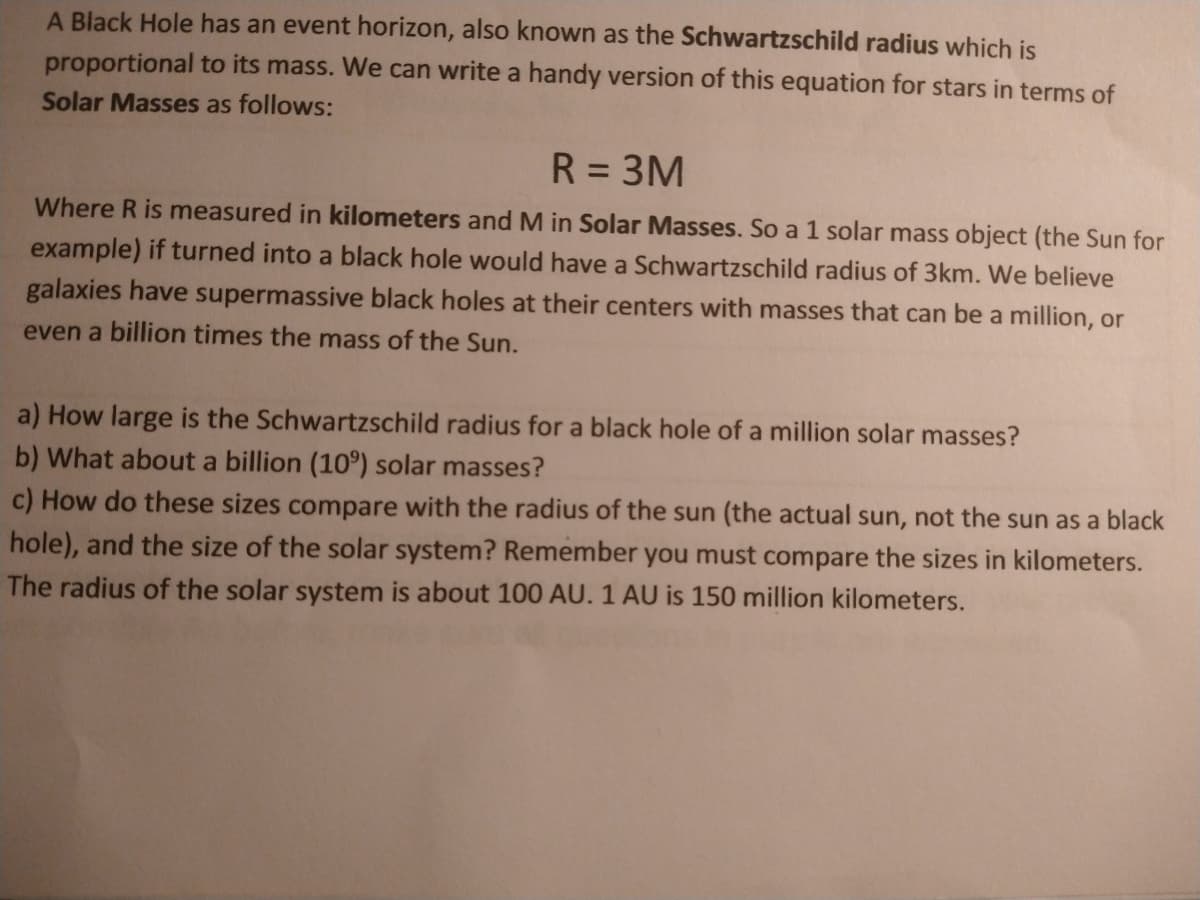a) How large is the Schwartzschild radius for a black hole of a million solar masses? b) What about a billion (10°) solar masses? c) How do these sizes compare with the radius of the sun (the actual sun, not the sun as a black hole), and the size of the solar system? Remember you must compare the sizes in kilometers. The radius of the solar system is about 100 AU. 1 AU is 150 million kilometers.
a) How large is the Schwartzschild radius for a black hole of a million solar masses? b) What about a billion (10°) solar masses? c) How do these sizes compare with the radius of the sun (the actual sun, not the sun as a black hole), and the size of the solar system? Remember you must compare the sizes in kilometers. The radius of the solar system is about 100 AU. 1 AU is 150 million kilometers.
Applications and Investigations in Earth Science (9th Edition)
9th Edition
ISBN:9780134746241
Author:Edward J. Tarbuck, Frederick K. Lutgens, Dennis G. Tasa
Publisher:Edward J. Tarbuck, Frederick K. Lutgens, Dennis G. Tasa
Chapter1: The Study Of Minerals
Section: Chapter Questions
Problem 1LR
Related questions
Question

Transcribed Image Text:A Black Hole has an event horizon, also known as the Schwartzschild radius which is
proportional to its mass. We can write a handy version of this equation for stars in terms of
Solar Masses as follows:
R = 3M
%3D
Where R is measured in kilometers and M in Solar Masses. So a 1 solar mass object (the Sun for
example) if turned into a black hole would have a Schwartzschild radius of 3km. We believe
galaxies have supermassive black holes at their centers with masses that can be a million, or
even a billion times the mass of the Sun.
a) How large is the Schwartzschild radius for a black hole of a million solar masses?
b) What about a billion (10°) solar masses?
c) How do these sizes compare with the radius of the sun (the actual sun, not the sun as a black
hole), and the size of the solar system? Remember you must compare the sizes in kilometers.
The radius of the solar system is about 100 AU. 1 AU is 150 million kilometers.
Expert Solution
This question has been solved!
Explore an expertly crafted, step-by-step solution for a thorough understanding of key concepts.
This is a popular solution!
Trending now
This is a popular solution!
Step by step
Solved in 3 steps

Recommended textbooks for you

Applications and Investigations in Earth Science …
Earth Science
ISBN:
9780134746241
Author:
Edward J. Tarbuck, Frederick K. Lutgens, Dennis G. Tasa
Publisher:
PEARSON

Exercises for Weather & Climate (9th Edition)
Earth Science
ISBN:
9780134041360
Author:
Greg Carbone
Publisher:
PEARSON

Environmental Science
Earth Science
ISBN:
9781260153125
Author:
William P Cunningham Prof., Mary Ann Cunningham Professor
Publisher:
McGraw-Hill Education

Applications and Investigations in Earth Science …
Earth Science
ISBN:
9780134746241
Author:
Edward J. Tarbuck, Frederick K. Lutgens, Dennis G. Tasa
Publisher:
PEARSON

Exercises for Weather & Climate (9th Edition)
Earth Science
ISBN:
9780134041360
Author:
Greg Carbone
Publisher:
PEARSON

Environmental Science
Earth Science
ISBN:
9781260153125
Author:
William P Cunningham Prof., Mary Ann Cunningham Professor
Publisher:
McGraw-Hill Education

Earth Science (15th Edition)
Earth Science
ISBN:
9780134543536
Author:
Edward J. Tarbuck, Frederick K. Lutgens, Dennis G. Tasa
Publisher:
PEARSON

Environmental Science (MindTap Course List)
Earth Science
ISBN:
9781337569613
Author:
G. Tyler Miller, Scott Spoolman
Publisher:
Cengage Learning

Physical Geology
Earth Science
ISBN:
9781259916823
Author:
Plummer, Charles C., CARLSON, Diane H., Hammersley, Lisa
Publisher:
Mcgraw-hill Education,